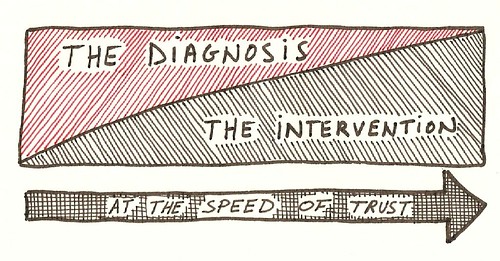Diagnostic Interventions is a term I borrow from Edgar Schein. His insights on the level of relationship management are applicable in a context of organizational change management, coaching and counseling.
Schein uses the term Diagnostic Interventions to indicate that consultants should be aware of the fact that each contact they have with the client is an intervention. We may think we are only diagnosing or ‘just asking some questions’, but in reality we are interrupting the reality of the person being interviewed.
Diagnostic Interventions?
A whole dynamic of questions, reactions and assumptions is put in motion once we have started our diagnosis. Who is that consultant? Why is he asking those questions? And why is he coming to me? If you fail to frame the purpose of your interview these questions will start to lead their own life in the back channel. Therefore it’s crucial to have your act together and make sure you have a conversation about the conversation before actually starting it.
Diagnostic Interventions are the best way to involve members of the organization in the change program. By asking them relevant questions about the present state, you not only learn relevant facts about possible resistance to change, but you also begin to influence their thinking and get them involved in the planning. You need to recognize that no matter how neutral and innocent the questions may be, they will influence the thinking of the people in the organization.
The Anatomy of Diagnostic Interventions
As I work my way though an organizational change project I often notice that every diagnostic is an intervention and that every intervention can serve as a diagnostic. This is shown in the drawing above. I think that there is a correlation between the diagnosis and the intervention and that the balance of the two depends on the level of trust.
For instance: if I am visiting a site manager of a multinational organization for an interview in order to determine the scope of a project (i.e.: even before the project has been called into existence) the level of trust is low and there is very little intervention I can do. I am at the complete left side of the drawing. The one thing I should recognize is that the level of trust is low and therefore I need to frame the purpose of my visit with care. This is often done in preliminary meetings with the sponsor of the program. After all, as a consultant, you are a foreign element and often a first sign that the boat is going to be rocked.
Consider that I am meeting this same site manager at the moment of implementation of the change program. Time has passed, work has been delivered and we had the chance on multiple occasions to build a mutual relationship. I am now on the right-hand side of the drawing. This means that I am able to get some work done in co-creation with this site manager because the level of trust has increased. At the same time I should be aware that there is still some temperature that I can measure on-site.
The Moral of Diagnostic Interventions
The concept of Diagnostic Interventions pulls our attention to the fact that we need to split our brains:
- When we are diagnosing a situation we are influencing it. Therefore we need to be aware of the consequences of that intervention and frame the purpose of the diagnosis;
- When we do an intervention we should be aware of the diagnostic opportunities. Don’t take things for granted and ask how people are doing.
There is always a little of both – diagnosis and intervention – when we have a contact with the customer.



